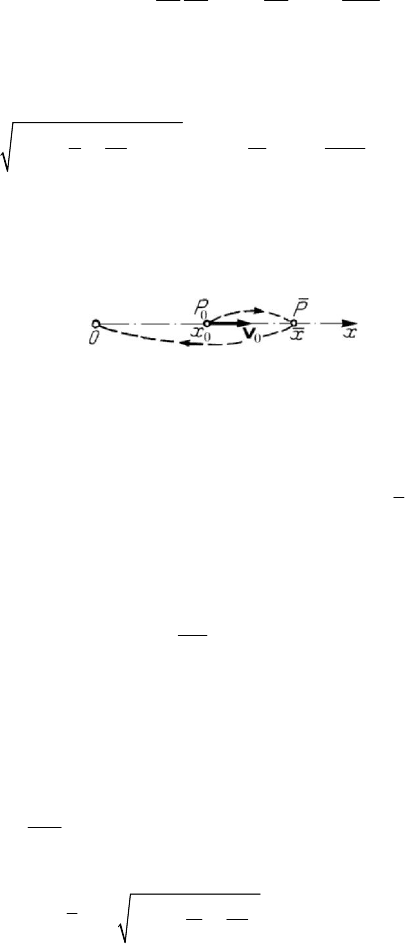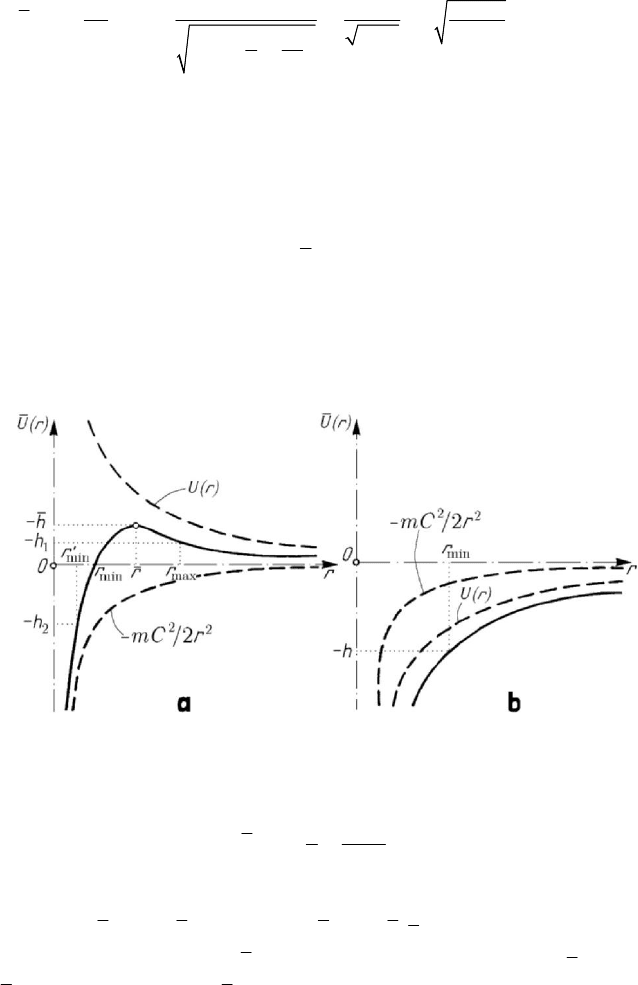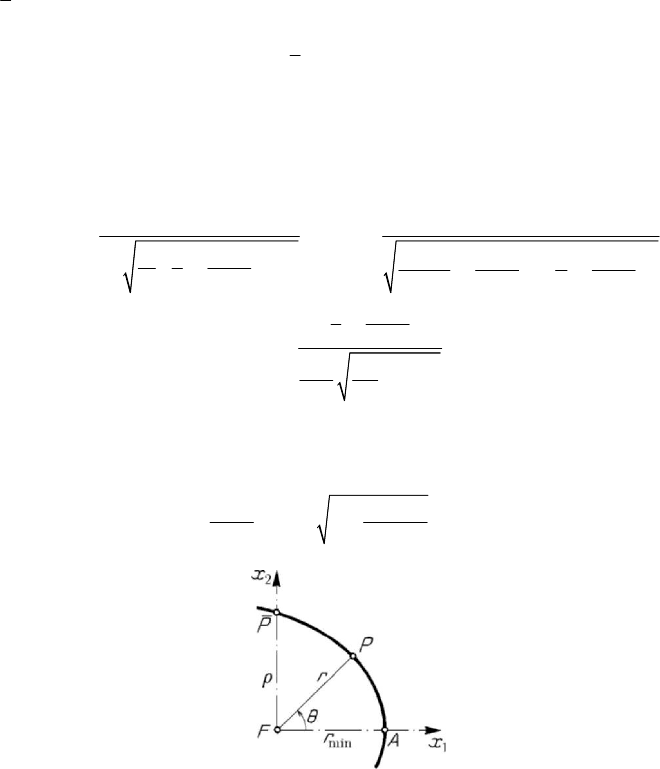Teodorescu P.P. Mechanical Systems, Classical Models Volume I: Particle Mechanics
Подождите немного. Документ загружается.


MECHANICAL SYSTEMS, CLASSICAL MODELS
552
From the formula (9.1.12) too, it results that the force obtained by applying the
operator gradient vanishes at infinity as
2
1/r . So, in the study of the solar system (the
motion of the planets around the Sun) one can neglect the action of other celestial
bodies, those ones being situated at distances practically infinite with respect to the
distances of the planets to the Sun or between them.
The properties i)-iv) characterize the Newtonian potential. Indeed, if there exists
another potential
()U
′
r which has these properties, then () ()UU
′
−
rr is a harmonic
function in the whole space, vanishing at infinity; from the theorem of maximum of
harmonic functions it results that the two potentials differ by a constant, which –
obviously – is equal to zero.
1.2.2 Potential of simple stratum of a homogeneous sphere
In case of a homogeneous sphere, the potential of simple stratum is given by the
surface integral
d
()
S
S
U
R
μ=
∫
∫
r , R
=
−r
ξ
,
(9.1.13)
where the equation of the sphere
S of radius
0
ξ reads
0
ξξ
=
. Because of spherical
symmetry, the potential depends only on the distance from the attracted particle to the
centre of the sphere, so that
()UU
=
r , rOP==
J
JJG
r . Choosing the point P on the
3
Ox -axis and using spherical co-ordinates (colatitude θ and longitude ϕ ) for Q ∈ S ,
we may write (
222
00
2cosRr rξξθ=+− )
2
2
0
22 22
00
00 00
sin d d
sin d
() d
2cos 2cos
S
U
rr rr
ππ
ξ θθϕ
θθ
μμϕ
ξξθ ξξθ
==
+− +−
∫∫ ∫ ∫
r
()
22
00 0
2
000
0
0
2cos 2
2
rr
rr
rr
π
ξξθ πμξ
πμξ ξ ξ
ξ
+−
==+−−
2
0
0
000
2
0
0
4 for ,
4 for ,
4 for ;
r
r
r
r
r
ξ
πμ ξ
πμξ ξ ξ
ξ
πμ ξ
⎧
−≤−
⎪
⎪
⎪
=−≤≤
⎨
⎪
⎪
≥
⎪
⎩
observing that the total superficial mass is
2
0
4m πμξ= , it results
0
for exterior to the sphere ,
() ()
const otherwise.
m
PS
r
UUr
m
ξ
⎧
⎪
==
⎨
=
⎪
⎩
r
(9.1.14)

Newtonian theory of universal attraction
553
We can thus state that a particle situated outside the homogeneous sphere
S is
attracted towards its centre as if the whole superficial mass of attraction would be
concentrated at this point (corresponding to the property iv) in the preceding
subsection); if the particle is situated on the sphere or in its interior, no force of
attraction is acting upon it. The potential
()U r is harmonic ( 0U
Δ
= ) in the whole
space and vanishes at infinity.
We notice also that
/Un∂∂ has a jump by passing through the surface S (the
normal derivative is equal to
4πμ
−
if P tends to S from the exterior and is equal to
zero for
P tending to S from the interior), although ()U r is a continuous function in
the whole space.
1.2.3 Volume potential of a homogeneous sphere
The volume potential of the homogeneous sphere
0
(0, )S ξ is given by (9.1.8''); with
the same observations as at the preceding subsection, we may write (we use spherical
co-ordinates
,,ξθϕ too; for P at the interior of the sphere S we make a separate
integration, as
0 rξ≤≤ or as
0
r ξξ
≤
≤ )
0
2
2
2
22 22
00 0
sin d d d sin d
() d d
2cos 2cos
V
U
rr rr
πξ π
ξθξθϕ θθ
μμϕξξ
ξξθ ξξθ
==
+− +−
∫∫∫ ∫ ∫ ∫
r
()
0
0
2
drr
r
ξ
πμ
ξξ ξξ=+−−
∫
2
2
0
3
0
2 for interior to the sphere ,
3
4
otherwise.
3
r
PS
r
πμ ξ
ξ
πμ
⎧⎛ ⎞
−
⎜⎟
⎪
⎪
⎝⎠
=
⎨
⎪
⎪
⎩
Observing that the total mass is
3
0
4/3m πμξ=
, it results
2
00
3 for interior to the sphere ,
2
() ()
otherwise.
mr
PS
UUr
m
r
ξξ
⎧⎡ ⎤
⎛⎞
−
⎜⎟
⎪
⎢⎥
⎪
⎝⎠
⎣⎦
==
⎨
⎪
⎪
⎩
r
(9.1.15)
As in case of the potential of simple stratum, a particle situated outside the
homogeneous sphere
S is attracted by its centre as if the whole mass would be
concentrated at this point (Newton’s modelling of the celestial bodies as particles is
thus justified). The potential
()U r and its derivatives of first order are continuous
functions in the whole space; the derivatives of second order of this potential have
discontinuities by crossing the surface
S and U
Δ
is given by (9.1.10). For numerical
computations we may take
6
0
6.37827 10 mξ =⋅.

MECHANICAL SYSTEMS, CLASSICAL MODELS
554
In case of a homogeneous spherical stratum of mass
m , contained between two
spheres
e
S and
i
S of centre O and radii
e
ξ and
e
i
ξξ
<
, respectively, we can use the
parallelogram principle (independence of the action of forces), obtaining thus
(
)
()
22
33
2 for interior to the sphere ,
()
4
for exterior to the sphere ,
3
e
ii
ee
i
PS
Ur
m
PS
rr
πμ ξ ξ
πμ
ξξ
−
⎧
⎪
=
⎨
−=
⎪
⎩
(9.1.16)
where
m is the mass of the spherical stratum. We are led to the same mechanical
conclusions as above.
We notice that we can obtain the same results for the volume potential starting from
the equation (9.1.10) written in spherical co-ordinates (
(
)
(
)
22
1/ (d/d ) d/drrrrΔ=
in case of spherical symmetry, corresponding to the formula (A.2.42')). For instance, in
case of the volume potential of the sphere
0
(0, )S ξ we have
2
d()
d
0
dd
Ur
r
rr
⎛⎞
=
⎜⎟
⎝⎠
,
wherefrom
12
() /Ur C r C=+,
12
,constCC
=
; from (9.1.12) it results that
1
Cm=
,
2
0C =
.
1.2.4 Potential of the terrestrial spheroid
In a better approximation, the Earth must be considered as a spheroid. Taking into
account the Maclaurin series in Subsec. 1.2.1, the volume potential is given by
1
0
1
() (cos )()d
n
n
n
V
n
UPV
r
ξψμξ
∞
+
=
=
∑
∫∫∫
r ,
(9.1.17)
for a particle
P
in the exterior of the Earth attractive mass. Corresponding to the first
two Legendre polynomials, we notice that (the mass of the Earth and its static moment
with respect to a plane normal to
OP
and passing through the pole
O
– centre of the
Earth)
()d
V
Vmμξ =
∫∫∫
, cos ( )d 0
V
Vξψμξ
=
∫∫∫
;
the third Legendre polynomial leads to
() ()
22 2 2
3cos 1 ( )d 2 3sin ( )d 2 3
O
VV
VVII
ξ
ξ ψ μξ ξ ψ μξ−=− =−
∫∫∫ ∫∫∫
,
where
O
I is the polar moment of inertia of the Earth with respect to its centre, while I
ξ
is the axial moment of inertia with respect to OP . Choosing the principal axes of
inertia
2O and 3O in the equatorial plane and the axis 1O along the axis of the Earth (so
that
123
III>>), we may write (we use the formulae (3.1.23) and (3.1.82''))

Newtonian theory of universal attraction
555
123
2
O
IIII=++ and
222
11 22 33
I InInIn
ξ
=++, where
i
n , 1, 2, 3i
=
, are the
direction cosines of the straight line
OP
with respect to these axes; in spherical co-
ordinates, we have
1
cosn θ=
,
2
sin cosn θϕ
=
,
3
sin sinn θϕ
=
, so that
(
)
(
)
(
)
222 22
12 3
2 3 1 3 cos 1 3sin cos 1 3sin sin
O
III I I
ξ
θθϕθϕ−= − + − + −
()
()
23
22
123
3
1 3 cos sin cos 2
22
II
III
θθϕ
+
⎛⎞
=− − − −
⎜⎟
⎝⎠
.
Calculating the principal moments of inertia of the Earth, we get
6
231
()/10/3III
−
−<
; in this case, we may assume that
23
II≅ (which
corresponds to the spheroidal model accepted for the Earth). Thus, we deduce
(
)
2
12
3
31
() () ( ) cos
3
2
m
UUr II
r
r
θ==+ − −r ,
(9.1.18)
where
m is the mass of the Earth.
In case of the spherical model of the Earth, we find again the result in the preceding
subsection (formula (9.1.15)).
For a more exact result, one may use the polynomial
3
(cos )P ψ too.
These results are very important in the study of the motion of artificial satellites of
the Earth.
2. Motion due to the action of Newtonian forces of attraction
We have seen that, in the classical model of mechanical systems, the celestial bodies
are subjected only to the action of internal forces (forces of Newtonian attraction). This
allows a study of the motion of planets, of artificial satellites of the Earth, of
interplanetary vehicles, as well as of other types of motion at the atomic level etc. We
notice that we will study, e.g., the motion of a celestial body (modelled as a particle)
with respect to another celestial body, considered as fixed, hence the motion of a
particle subjected to the action of a central force.
2.1 Motion of celestial bodies
After a general study of the motion of a particle acted upon by a central force of the
nature of a Newtonian attraction force (elliptic, hyperbolic or parabolic trajectories), we
will consider the motion of planets and comets; we put in evidence the deviation of the
light ray too.
2.1.1 Rectilinear motion due to the action of a Newtonian force of attraction
If the initial velocity
0
v is directed along
00
OP
=
J
JJJG
r , where
0
P is the initial position,
then (as we have seen in Chap. 8, Subsec. 1.1.2) the trajectory of the particle
P is
rectilinear; it is assumed that there exists a centre of attraction at
O (a particle of mass
M ), the particle P of mass m being subjected to a force of Newtonian attraction

MECHANICAL SYSTEMS, CLASSICAL MODELS
556
3
/
f
mMOP x=−
J
JJG
F (we choose the corresponding trajectory as Ox -axis). The
equation of motion
2
dd d
dd d
vx v mM
mx mv m mv f
xt x
x
== = =−
leads to
2
/2 /mv fmM x h=+, hence to a conservation law of mechanical energy, h
being the energy constant; the initial conditions (
0
(0)xx
=
,
0
(0)vv
=
) allow to write
2
0
0
11
2vfM v
xx
⎛⎞
=± − +
⎜⎟
⎝⎠
,
2
0
0
2
2
mfM
hv
x
⎛⎞
=−
⎜⎟
⎝⎠
.
(9.2.1)
We assume that
0
0x > (the positive direction of the Ox -axis is towards the initial
position); one cannot have
0
0x
=
, from the mechanical point of view. One takes the
sign ± before the radical as
0
0v ≷ .
Figure 9.4. Rectilinear motion due to the action of a Newtonian force of attraction.
If
0
0v ≤
, then the particle comes near to the point
O
( d/d 0xt
<
) with a velocity
increasing in absolute value, which tends to infinity for
00x →+. If
0
0v >
, then
the particle moves away from the point
O
(d/d 0xt> ); if
0h ≥
, then the particle
tends to infinity, while if
0h
<
it stops at the point of abscissa 2/xfMh
=
− , where
the velocity changes of sign and returns, as in the foregoing case (Fig.9.4).
Modelling the Earth as a particle of mass
M
and denoting
0
xR
=
, where R is the
radius of the Earth, approximated as a sphere, the condition
0h ≥
leads to
2
0
2
f
M
v
R
≥
,
(9.2.2)
where we took into account (9.2.1). Introducing numerical values, we find that a
particle from the Earth surface must be launched up along the local vertical with an
initial velocity
II
vv≥ (
II
11.2 km/sv
≅
being the second cosmic velocity, see
Subsec. 2.2.2) so as not to return on the Earth; obviously, the resistance of the air has
been neglected.
In case of a particle which falls on the Earth without initial velocity from the initial
position
00
xx OP== , we obtain the velocity at the Earth surface (the falling
velocity)
0
11
2vfM
Rx
⎛⎞
=− −
⎜⎟
⎝⎠
;
(9.2.3)

Newtonian theory of universal attraction
557
if
0
xRH=+, HR , and if we take into account Torricelli’s formula (7.1.17),
then we find again the formula (1.1.85). Also from (9.2.1), one obtains the falling time
0
00
0
0
0
dd1
d
2
11
2
RR x
xx R
xx
xx
tx
vxx
fM
fM
xx
==− =
−
⎛⎞
−
⎜⎟
⎝⎠
∫∫ ∫
.
(9.2.3')
2.1.2 Curvilinear motion due to the action of a Newtonian force of attraction.
Newton’s problem. Runge-Lenz vector
Starting from the results obtained in Sec. 1.2, we may consider the motion of a
particle in a field of central forces given by a potential of the form
()
k
Ur
r
=
;
(9.2.4)
thus, the Newtonian gravitational field is of attraction (
0kfmM
=
> ), while the
Coulombian one (specified by (1.1.84'')) may be an attractive or a repulsive field,
depending on the relative signs of the charges in interaction (
0k >
or
0k <
,
respectively).
Figure 9.5. Apparent potential: attractive (a); repulsive (b).
We introduce the apparent potential (8.1.6') in the form
2
2
()
2
kmC
Ur
r
r
=−
.
In case of a potential of attraction (
0k > ), we represent the apparent potential in
Fig.9.5,a. At
()Ur h=− corresponds
max
()UUr= , the orbit being circular; an
elementary calculus shows that
22
/2hkmC=− , with an orbit radius
2
/rmCk= .
If
1
()Ur h≥− ,
1
0 hh<− <− , then the orbit is contained in the circular annulus of

MECHANICAL SYSTEMS, CLASSICAL MODELS
558
radii
min
r and
max
r , being a closed curve (in conformity to Bertrand’s theorem). For
2
()Ur h≥− ,
2
0h−<, we get a unbounded orbit with a pericentre at a distance
min
r
′
from the centre of attraction. In case of a repulsive potential (
0k
<
), we represent the
apparent potential in Fig.9.5,b; for
()Ur h≥− , 0h
−
< , there result only unbounded
orbits of pericentres at the distance
min
r from the repulsive centre.
Let us consider now the case of a Newtonian potential of attraction. We choose the
1
Ox -axis so as to be an apsidal line; the formulae (8.1.6'), (8.1.6'') lead to the equation
of the trajectory in polar co-ordinates in the form (we take
0
0θ
=
)
min
min
1/
22
1/
2
2
2
24 2 2
d(1/ )
d
2
21
2
rr
rr
C
kmC
kh k
h
mr
r
mC mC mC
ρ
ρ
θ
ρ
ρ
==
⎛⎞
⎛⎞
−+
+−−
⎜⎟
⎜⎟
⎝⎠
⎝⎠
∫∫
2
2
2
1
arccos
1
2
k
r
mC
k
mh
mC
C
−
=
+
,
where we took into account that
min
rr
=
corresponds to 0θ
=
. We obtain thus the
equation (9.1.1) of a conic, with
2
mC
p
k
= ,
2
2
2
1
mC h
e
k
=+ .
(9.2.5)
Figure 9.6. Curvilinear motion due to the action of a Newtonian force of attraction.
In Cartesian co-ordinates, there results (we notice that
1
cosxrθ
=
) (Fig.9.6)
22 2
12 1
()0xx exp
+
−−=;
(9.2.5')
the conic pierces the co-ordinate axes at the points
min
(,0)r and (0, )p , obtaining thus
a geometric interpretation for the parameter of the conic too. Taking into account the
eccentricity, it is seen that the trajectory is an ellipse, a parabola or a hyperbola as
0h < , 0h
=
or 0h > , respectively; in particular, if
22
/2hkmC=−
, then we have
0e = , so that the ellipse is a circle.

Newtonian theory of universal attraction
559
We may obtain an equivalent form of this result starting from Binet’s equation
(8.1.4). Introducing the force of Newtonian attraction
2
/FfmMr=− , where M is
the mass of the attractive particle, we get the equation
(
)
2
22
d1 1
d
f
M
rr
C
θ
+= ,
wherefrom
12
2
1
cos( )
f
M
CC
r
C
θ=−+,
12
,CC
being two scalar integration constants; with the notations
1
/Cep
=
,
21
C θ=
,
2
/pC fM=
, we find again the equation of the conic with respect to the focus
F and
an axis inclined by
1
θ towards the apsidal line, in the form
1
1cos( )
p
r
e θθ
=
+−
.
(9.2.6)
If we put the initial conditions at the moment
0
tt
=
as in Chap. 8, Subsec. 1.1.1, then
we may express the conic parameter in the form
22 2
2
00 0
sinrv
C
p
f
MfM
α
==
.
(9.2.7)
We use the conditions (8.1.4'') to determine the eccentricity
e and the angle
1
θ ,
obtaining thus
0
1
0
1cos( )
p
e
r
θθ+−=,
00
1
0
sin( ) cot
p
e
r
θθ α−= ,
wherefrom
2
2
22
0
22
00
000
1cot1 2
sin
pp pp
e
rr
rr
α
α
⎛⎞
⎛⎞
=−+ =+ −
⎜⎟
⎜⎟
⎝⎠
⎝⎠
22 2
00 0 00
sin
12
rv rv
fM fM
α
⎛⎞
=+ −
⎜⎟
⎝⎠
,
2
000 0 0
0
1
22
0
00 0
cot sin cos
tan( )
sin
prv
pr
rv fM
ααα
θθ
α
−= =
−
−
.
(9.2.7')
Hence, the trajectory is an ellipse, a parabola or a hyperbola as
2
00
2rv fM< , as
2
00
2rv fM= or as
2
00
2rv fM> , respectively. The genus of the conic depends thus

MECHANICAL SYSTEMS, CLASSICAL MODELS
560
only on the initial distance to the centre of attraction (radius
0
r ), on the intensity of this
centre (mass
M ) and on the magnitude of the initial velocity (velocity
0
v ), but does
not depend on the direction of this velocity (angle
0
α ). For the condition 0e = , it
results (
0
/2απ= , so that
0
sin 1α
=
)
22
00 00
21
rv rv
fM fM
⎛⎞
−
=−
⎜⎟
⎝⎠
;
hence, the orbit is circular if
2
00
rv fM= . These conditions are equivalent to those
previously obtained, because the energy constant (the mechanical energy at the initial
moment) is given by
2
00
/2 /hmv fmMr=−
.
The angle
(, )α = ) rv (see Fig.8.1) is given by (
2
rCθ
=
)
d
tan
d
r
v
rCr
vrrr r
θ
θθ
α ====
;
(9.2.8)
taking into account (9.2.6) we may also write
1
tan
sin( )
p
re
α
θθ
=
−
.
(9.2.8')
We denote
1
π
θθ= too, because for
π
θθ
=
we obtain
min
/(1 )rpe
=
+ , hence the
pericentre. The angle
π
ψθθ=− is called true anomaly, representing the angular
distance of the particle with respect to the pericentre.
From the law of areas it results
22
dddCt r rθψ==; taking into account the
equation of the conic
/(1 cos )rp e ψ=+ and its parameter
2
/pC fM= , we may
also write
22
3/2
d
dd
(1 cos )
CfM
tt
ep
p
ψ
ψ
==
+
.
With the notation
tan
2
ψ
η
= ,
(9.2.9)
we obtain
2
2d
d
1+
η
ψ
η
=
,
2
2
1
cos
1
η
ψ
η
−
=
+
,
so that the law
()tηη= , hence the law ()tψψ
=
too, is given by the differential
equation with separate variables

Newtonian theory of universal attraction
561
(
)
()
2
22
3/2
2
1d
2
(1 )
1
f
M
e
p
ηη
γη
+
=
+
+
,
1
1
e
e
γ
−
=
+
,
(9.2.9')
which will be integrated taking into account the nature of the conic.
The formula (8.1.6''') allows to find the law of motion of the particle along the
trajectory in the form
min
0
2
2
d
22
r
r
tt
kC h
mm
ρ
ρ
ρ
=+
−+
∫
.
(9.2.10)
In the study of Newton’s problem we used till now two first integrals, corresponding
to the conservation of the moment of momentum (a vector first integral, equivalent to
three scalar first integrals) and to the conservation of the mechanical energy (a scalar
first integral), respectively; hence, it results that the trajectory is a plane curve and that
one can determine the motion on it (from the first integral of areas, which is a
component of the first integral of moment of momentum, or from the first integral of
mechanical energy). The formula (8.1.6'') or Binet’s equation may be replaced by a
third first integral specific for a field of Newtonian attraction. In case of a central force
versF=Fr, (,;)FF t=
rr , we may write, starting from Newton’s equation
d
() ()
d
OOO
mF
mm F
trr
×= × =×= ××
r
rK rK K r rr
,
where we took into account the conservation theorem of moment of momentum
(
O
=
K0
); it results (we notice that rr
⋅
=
rr , in conformity to the formula (A.1.12))
(
)
22
2
d
() ()() ()
d
O
FF r
rFrr rF
tr r r
r
×=××= ⋅−= −=− −
⎡⎤
⎣⎦
r
rK r rr rrr r r r r
,
so that
(
)
2
dd
()
dd
O
rF
ttr
×=−
r
rK
.
Hence, if
2
constrF=
(in the above considered case
2
/FfmMr=−
), then we may
introduce the vector
O
f
mM
r
=× −
r
rKR
,
(9.2.11)
called the Runge-Lenz vector, which is conserved in time along the trajectory of the
particle (
d/dt = 0R , hence const
=
J
JJJJG
R
), being a vector first integral of the motion,
equivalent to three scalar first integrals. One obtains thus seven scalar first integrals
